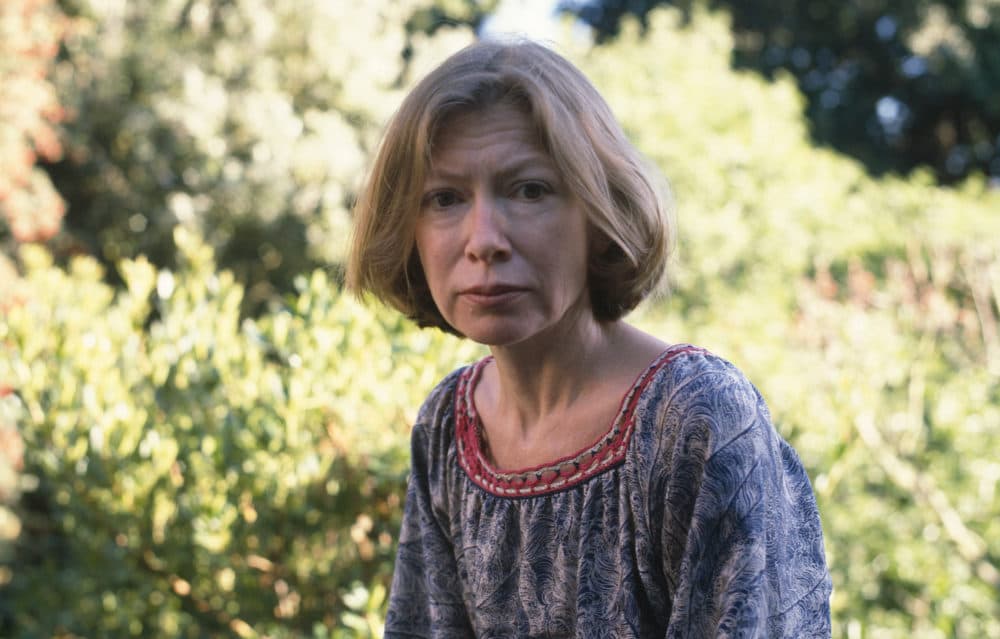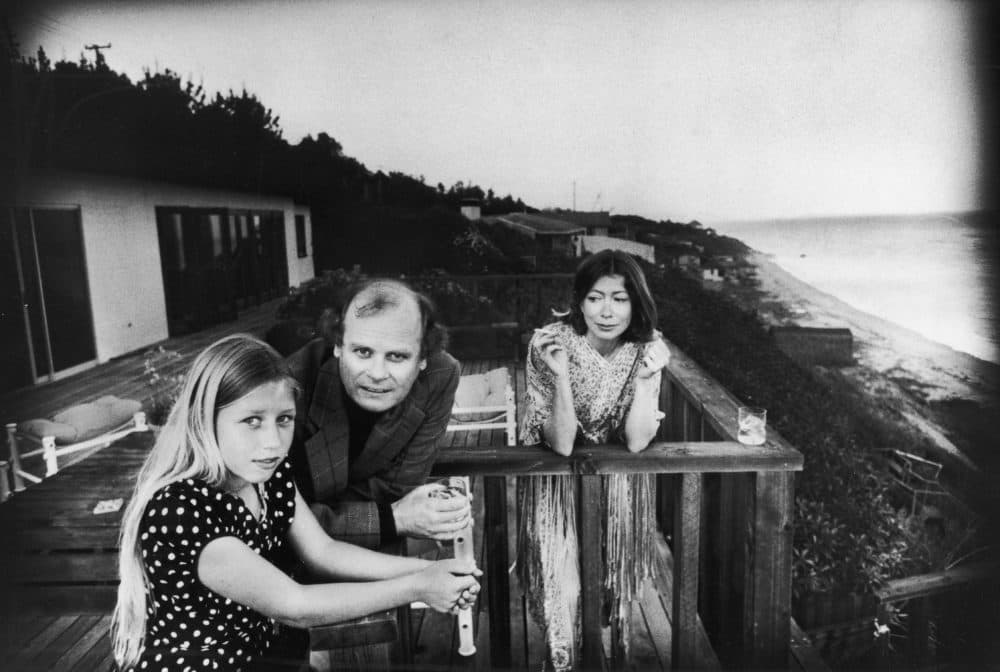Advertisement
Commentary
My time with Joan Didion

Many years ago, in the early ‘80s, the phone rang at my desk at the Miami Herald and the speaker identified herself as Joan Didion, saying she would be in Miami the following week to research a book. I may not be the best detective in the world but I could tell the voice was all wrong: twangy, with a high pitch, not the whispered alto I would have expected from a writer who pursued dread and disassociation as if they were both elusive whales, a writer whose prose was nothing less than lapidary. I was certain I was being set up.
Yet, as the person spoke, there was something about the words themselves. A kind of fingerprint, a methodical, trellis-like rhythm. Then the key phrase: “Gene Miller told me to be in touch.” Miller was a kingpin at the Herald, an editor famous for his cowlick, his bow tie, and a writing style called “the Miller Chop” — the shorter the better. He knew everyone.
For years, like just about every female journalist of my era, I had worshipped Didion from afar. We came of age during a time of race riots, Vietnam, and assassinations. Didion, a good 15 to 20 years older, was the prototype. We called her St. Joan, without irony. Her first collection of essays, “Slouching Toward Bethlehem,” provided a blueprint for all we hoped to be.
There she was, nervous and slight, marking time in a motel room, afraid to pick up the phone and call the assistant district attorney. “Writers,” she wrote, “are always selling someone out.”
She had a much lighter manner in person than on paper.
Next, she is writing about Lucille Miller, murderess in the golden land of the San Bernardino Valley, an empty paradise where the fruit struggles to grow in what she called an “ominous country,” abandoned even by the Mormons.
“This is the California where it is possible to live and die without ever eating an artichoke, without ever meeting a Catholic or a Jew. This is the California where it is easy to Dial-A-Devotion but hard to buy a book…the country of the teased hair and the Capris, where all life’s promises comes down to a waltz-length white wedding dress and the birth of a Kimberly or Sherry or a Debbi and a Tijuana divorce and a return to hairdressers’ school.” Then she was roaming around in hippie hell on Haight Street in San Francisco: “People were missing. Children were missing. Parents were missing.” She kept a notebook. Her first was a Big Five tablet, a gift from her mother who offered it with the “sensible suggestion that I stop whining and learn to amuse myself by writing down my thoughts…The first entry is an account of a woman who believed herself to be freezing to death in the Arctic night, only to find, when day broke, that she had stumbled onto the Sahara Desert, where she would die of the heat before lunch. I have no idea what turn of a five-year-old’s mind could have prompted so insistently ‘ironic’ and exotic a story, but it does reveal a certain predilection for the extreme…”
She continued to affect ennui at a precocious age — a world-weariness about having had her fill of New York City by age 30. “It is,” she wrote when it came time to flee the city, “distinctly possible to stay too long at the fair.” Oh to be as jaded, on such a breath-taking scale.
She had exotic datelines, as in “I am sitting in a high-ceiling room in the Royal Hawaiian Hotel in Honolulu watching the long translucent curtains billow in the trade wind and trying to put my life back together.” She was intimate but only to a point: “We are here on this island in the middle of the Pacific in lieu of filing for a divorce.” What follows is more of a travelogue of the island than one of the heart. She could also be opaque on a breath-taking scale.
She was our Hemingway. Only better. Many years later when I became a professor at UMass Amherst, I would often assign students the task of memorizing their favorite Didion passage of a generous length and then reciting it to the entire class. No one ever objected.
She was our Hemingway. Only better.
The week after her initial call I gave her the grand tour of my Miami. We went to lunch at Versailles Restaurant, where I recommended the Galician white bean soup and café con leche. In Liberty City, we went to the intersection where a Black motorcyclist made the fatal error of running a red light, only to be cornered by a gang of cops who clubbed him to death. The subsequent acquittal of the police officers by an all-white jury in Tampa resulted in a race riot over three days in May of 1980, with 18 dead. Miami was still coiled and tense when Didion visited. I took her to the corner of Grand and Douglas in Coconut Grove and warned her against lingering too long at a red light.
After a mass we attended at a Catholic Church commemorating the Bay of Pigs, the congregation spilled out into the creamy night air and burst into song. A frail Didion turned on her tape recorder.
“What is this?” she mouthed.
I had become by then sufficiently Miami-ized that I was surprised by her lack of familiarity. “The Cuban National Anthem, naturally,” I answered, while parishioners passed around steaming thimble-sized cups of coffee. What planet are you from, I wanted to ask. California?
I did not get to know her well over those few weeks but some impressions are lasting. She had a much lighter manner in person than on paper. She even admitted that some people expect her to have a big letter “D” on her forehead for “depressed.” As proof that this was not the case, she said the piano in her home in California always had a vase filled with fresh flowers, a detail I took as a confidence but I later learned had appeared in one of her essays. At the end of many a work day, she joined us at our house for dinner and a debriefing. Every evening at about 6:30 she asked for water so as to swallow a single small pill about which she gave no explanation. She could be surprisingly normal, sharing worries about her daughter. She and her husband John Dunne adopted the child shortly after her birth and named her Quintana Roo, after a province in Mexico. The girl was now a late teen dealing with a bad case of acne and having trouble at school — she might want transfer.

Didion helped me feed my 3-year-old son his usual nightly menu of tater tots. chicken nuggets and sliced bananas, and prepare him for bedtime. I am not big on celebrity photos but I wish I had taken one of Didion bathing Nick as he clutched a rubber duck. She crouched by the low blue tub with my sweet boy looking up at her, the high priestess of perfect diction, and the sound that issued from her mouth pleased him as much as it surprised me.
Joan Didion quacked.
When the book “Miami” came out, I was proud to be in the acknowledgements and sorry to realize that the relationship began and ended with that one project. I should have known better. I was just a source and journalists are at heart itinerants. Once one story is done, they are onto the next. Nonetheless there prevailed in my head some fantasy of friendship. I contacted her a decade or two later to see if I could lure her into a lucrative guest speaker slot, but to no avail. She behaved cordially, claiming to remember me: “Some people you never forget.” I am not sure if that was true or just her standard way of letting people down softly.
What planet are you from, I wanted to ask. California?
We never did see each other again, but I kept in touch at my end, reading pretty much everything she wrote in the intervening years. I was struck by the courage (a word she would have likely decried as unearned, hallow and inflated, like Hemingway’s “sacred, glorious, and sacrifice”) in writing about the death of her husband in “The Year of Magical Thinking.” Wait, there’s proof that the word irked her. One has only to look at the two standalone quotes at the beginning of “Slouching.” One is from Yeats and other from Peggy Lee: “I learned courage from Buddha, Jesus, Lincoln, Einstein, and Cary Grant.”
Didion’s daughter died at the age of 39 two years after her husband, and Didion explored grief anew in her book about her “Blue Nights.” The book earned great praise but also generated the tiresome Internet vitriol so common these days. One writer mocked Didion and Dunne’s choice of their daughter’s name and others impugned her mothering. Still, Didion persisted — the usual human dilemma. One can’t go on. One must.
When she died earlier this week, the New York Times, which is not always perfect, ended its obit perfectly with this line from her work. “You were meant, if you were a Californian, to know how to lash together a corral with bark, you were meant to show spirit, kill the rattlesnake, keep moving.”
A week or two before that my son called. He and his wife had just finished watching the Netflix documentary directed by Didion’s nephew Griffin Dunne, “The Center Will Not Hold.” Nick said Rebecca had never read any Didion and was now intrigued enough to try. I recommended “Slouching” and “The White Album” as a starter set. I had just recently purchased Didion’s latest, “Let Me Tell You What I Mean.” The day before she died, I could not resist a peak. This sounds made-up, but guess what, it’s not. I have my own complete set of Didion in my bookshelf directly across from my reading chair, accessible, and often accessed, at a moment’s notice.

In the new collection, I was drawn to an essay called “Last Words,” in which Didion wrote about Hemingway. She called him “a writer who had in his time changed the rhythms of the way both his own and the next few generations would speak and write and think. The very grammar of a Hemingway sentence dictated, or was dictated by, a certain way of looking at the world…”
You could swap out the name Hemingway for Didion and no one could accuse you of being on less than solid ground.
Fitting epitaphs abound. Some people you never forget and some writers you never stop learning from. Kill the rattlesnake. Keep moving.
